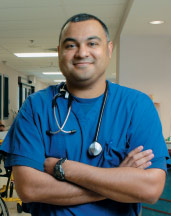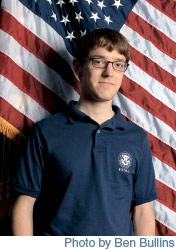| |
Hurricane relief
Poems from Alan Birkelbach
Homecoming photos
Bookshelf
What's Been Happening

New Orleans photos
Pet photos

Joey Dockins' blog
Hemant Vankawala's letter |
|
|
Hurricane Katrina
 'We found them mistakenly'
— Joey Dockins ('96), firefighter with the Cypress Creek Fire Department, assisting with rescue boat efforts in New Orleans 'We found them mistakenly'
— Joey Dockins ('96), firefighter with the Cypress Creek Fire Department, assisting with rescue boat efforts in New Orleans
Each day we headed out from the staging area around 7:30 a.m. and returned around 7:30 pm. It was an eerie feeling driving into downtown. The windows of the tall buildings were blown out, with drapes blowing in the wind. Every so often a lone piece of paper would drift down from above. We did not venture out in the boat without an armed officer on board.
My most rewarding rescue happened on our second day (Sept. 4). We were in an area that was very deep, probably more than 9 feet. We had just picked up a family of three and were headed back. We took a different street by accident and ran into Herman and Mrs. Rose, an elderly couple in their 80s. Mrs. Rose required a walking cane, and we had the task of getting the couple down off the second story across a short roof overhang and into the boat. They told us they had been waiting since day one for a helicopter or something to rescue them. And we found them mistakenly.
We later rescued a crowd from an apartment building. They were by far the liveliest bunch of folks. They were older individuals and would not leave unless they all agreed. They sang several songs for us, including "How to Say Goodbye," and we all joined in for "Jeremiah Was a Bullfrog." They were quite good, actually. The flood waters had not yet dampened their spirits.
We encountered countless people walking here or there in the water — some folks as deep as their neck and some swimming. They would not go with us. One group of two was going to feed a dog. There were several occasions in which residents would not leave because a loved one had passed away and they chose to stay until the body could be recovered.
 'Look into their eyes' — Hemant Vankawala ('96 M.S.), emergency room doctor at Denton Regional Medical Center and member of the Texas-4 Disaster Medical Assistance Team (part of FEMA), providing medical relief at the New Orleans airport 'Look into their eyes' — Hemant Vankawala ('96 M.S.), emergency room doctor at Denton Regional Medical Center and member of the Texas-4 Disaster Medical Assistance Team (part of FEMA), providing medical relief at the New Orleans airport
Our team was the first to arrive at the airport and set up our field hospital. We watched our population grow from 35 DMAT personnel taking care of six patients and two security guards to around 10,000 people in the first 15 hours. These people had had no food or water or security for several days and were tired, frustrated, sick, wet and heartbroken.
At any given time there were at least eight to 10 helicopters off-loading on the tarmac, filled with 10 to 40 survivors at a time, with 10 circling to land. The television footage does not even begin to do it justice — the roar of rotor blades, the smell of fuel and the thousands of eyes looking at us for answers, for hope.
Our busiest day we off-loaded just under 15,000 patients by air and ground. We practiced medical triage at its most basic, black tagging the sickest people and culling them from the masses so that they could die in a separate area. We were so short on wheelchairs and litters we had to stack patients in airport chairs and lay them on the floor. Imagine trading single-patient-use latex gloves for a pair of thick leather work gloves that never came off your hands and you can begin to imagine what it was like.
We filled the airport to its bursting point. Only after the thousands of survivors had been evacuated and the floors soaked in bleach, the putrid air allowed to exchange for fresh, and the number of soldiers allowed to outnumber the patients did we feel safe. Talk to the survivors, hear their stories and what they have been through, look into their eyes. You will never think of America the same way.
 ‘On-the-job training’ — Logan Monroe (’05), disaster assistance employee, FEMA Region VI Headquarters in Denton, deployed to Louisiana ‘On-the-job training’ — Logan Monroe (’05), disaster assistance employee, FEMA Region VI Headquarters in Denton, deployed to Louisiana
The Monday after I graduated (in August), I was doing geographical information systems work for Region VI when they decided to send me to New Orleans for two weeks of on-the-job training. FEMA was responding to Tropical Storm Cindy, which caused some minor damage to Louisiana in early July.
The first two days we were there, Katrina was out in the Gulf but was not a threat. Later that week, she shifted and intensified so we evacuated to Baton Rouge where we were deployed to Louisiana’s Emergency Operations Center. At the EOC, I worked in the planning section as a liaison to the state and as a resource tracking specialist.
The night before the storm, Baton Rouge was frantic. Because of the New Orleans evacuation, the population doubled overnight and traffic was horrible. I went to the grocery store, and it was a madhouse. The gas stations were already out of gas. The morning of the storm, I drove through the wind and rain and through downed power lines and broken traffic lights to get to the EOC.
After two weeks there, I was sent to the Joint Field Office in Baton Rouge where FEMA had established operations. The JFO was set up in an abandoned Dillard’s store with concrete floors and bare walls and about 3,000 people working from laptops at folding tables. I worked in the Situation Unit under the Planning Branch, writing briefing presentations and producing all the charts and graphs needed to support operations.
While in college, I worked at the FEMA call center in Denton, but Katrina was my first time working in the field. My two-week training deployment turned into one hell of an experience. 
Hurricane Rita
People and pets find refuge at UNT
For many residents of Beaumont, forced to flee their homes because of Hurricane Rita in September, escaping the storm's path was only the beginning. By the time displaced Beaumont citizens reached the American Red Cross shelter operated by UNT at the Mean Green Village (the former Liberty Christian School property on Bonnie Brae), many had been through quite an ordeal.
Several towns between Beaumont and Denton had been unable or unwilling to accept busloads of citizens, while others could only provide temporary shelter and assistance. Food was in short supply, and access to restrooms was limited or denied. When the evacuees arrived in Denton, they were tired, hungry and, in a few cases, sick.
The shelter at the Mean Green Village, which had been prepared for a few buses of elderly Beaumont citizens, was quickly transformed to accommodate a group of all ages, including about 50 children ranging from three months to 18 years old.
The evacuees were provided with meals, bedding and linens, medical assistance, toiletries, videos and games, transportation throughout Denton, telephone and computer service and 24-hour security. Children were also taken to a nearby park to play.
The shelter served about 200 people over several days, including some who evacuated from Houston before Rita hit.
In addition to the shelter for people, UNT and the North Texas Animal Rescue Alliance opened a pet shelter nearby. Operated by nearly 100 volunteers from 21 rescue groups across North Texas, the shelter eventually housed 27 animals, including a 9-foot boa constrictor, a bearded dragon, a parrot and cats and dogs. Two horses and a mule were stabled off site and seven other animals were placed in foster homes or kennels at the evacuees' request.
UNT provided the facility, and PetCo stores in Denton and Lewisville donated cages, crates and food. The North Texas Animal Alliance — a coalition of area rescue groups, veterinarians and businesses — pulled it all together and supervised the pets during their short stay in North Texas. |
|
|


